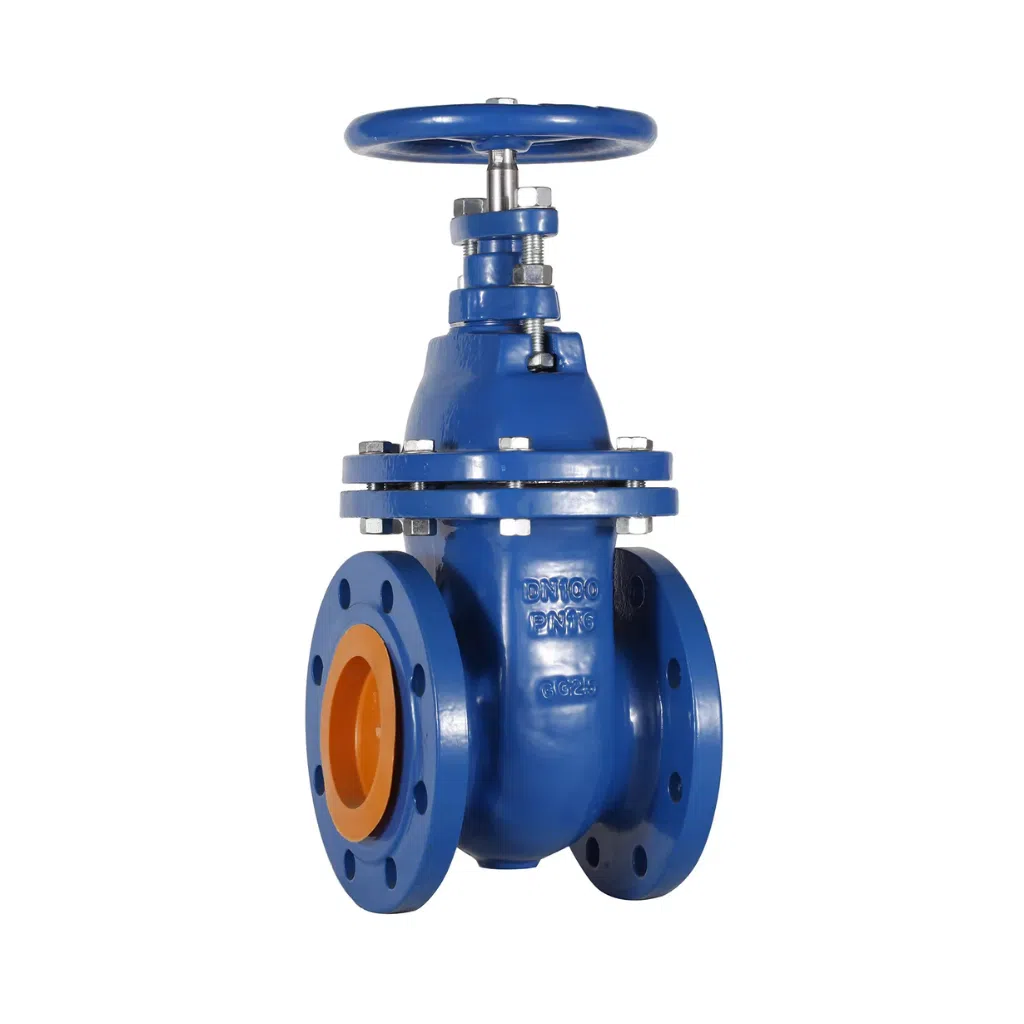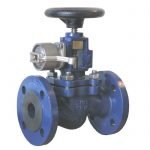A marine gate valve is a type of isolation valve used to completely stop or allow the flow of a fluid in a pipeline.1 It operates by lifting a wedge-shaped or rectangular “gate” out of the path of the fluid.2 When the valve is fully open, the gate is retracted, creating a clear, unobstructed path for the fluid with minimal pressure loss.3
Unlike a globe valve, a gate valve is designed for on/off control and is not suitable for regulating or “throttling” the flow.4 Using a gate valve partially open can cause significant damage to the gate and seating surfaces due to the high-velocity flow.5
Working Principle and Design
- Gate/Disc: The main component that moves to open or close the valve.6 It can be a solid wedge, a flexible wedge, or a parallel slide disc.
- Stem: A shaft connected to the gate.7 Turning a handwheel or an actuator causes the stem to move up or down, lifting or lowering the gate.8
- Rising Stem vs. Non-Rising Stem:
- Rising Stem: The stem moves up and down with the gate, providing a visual indication of the valve’s position.9 This is useful for easy inspection but requires more vertical space.
- Non-Rising Stem: The stem is threaded into the gate and rotates to move the gate up or down, but the stem itself does not move vertically.10 This is ideal for applications with limited space.11
- Rising Stem: The stem moves up and down with the gate, providing a visual indication of the valve’s position.9 This is useful for easy inspection but requires more vertical space.
Applications and Materials
Marine gate valves are essential for fluid control in various systems on a ship where a reliable shut-off is required.12
- Common Applications:
- Ballast and Bilge Systems: Controlling the intake, discharge, and transfer of seawater.13
- Seawater Cooling Systems: Isolating sections of the cooling water lines for maintenance.14
- Fuel Oil and Lubricating Oil Systems: Shutting off lines to tanks or machinery.15
- Fire Fighting Systems: Isolating fire mains for repair.
- Ballast and Bilge Systems: Controlling the intake, discharge, and transfer of seawater.13
- Materials: The choice of material is crucial for a valve’s longevity in the corrosive marine environment.16 Common materials include:
- Bronze / Gunmetal: Excellent corrosion resistance for seawater applications.17
- Cast Iron / Ductile Iron: Commonly used for low to medium-pressure applications.18
- Cast Steel: Used for high-pressure and high-temperature systems.19
- Stainless Steel: Provides superior corrosion resistance for demanding applications.20
- Bronze / Gunmetal: Excellent corrosion resistance for seawater applications.17
Maintenance and Common Issues
Proper maintenance is key to preventing a gate valve from seizing and failing to operate in an emergency.
- Routine Maintenance:
- Regular Operation: Valves should be cycled (opened and closed) periodically to prevent the gate from seizing in place.
- Inspection: Check for leaks from the stem packing gland and at the body-to-bonnet joint.
- Lubrication: Lubricate the stem threads to ensure smooth operation.21
- Common Issues:
- Leaking: Can be caused by worn stem packing, a damaged seat, or a loose bonnet.
- Failure to Close Tightly: Often due to foreign debris (e.g., rust, marine growth) caught on the seat or a damaged gate.
- Stiff Operation: Can be a result of corrosion, lack of lubrication, or sediment buildup.22
Spare Parts
For a gate valve overhaul or repair, a vessel’s spares inventory should include:
- Gaskets: For sealing the bonnet to the body.23
- Stem Packing: A kit of packing material for the stuffing box to prevent leaks around the stem.24
- Gate / Wedge: A new gate or wedge for replacement in case of severe wear or damage.25
- Seats: Replacement seat rings, which can be machined or replaced.26
- Bolts and Nuts: For securing the bonnet and flanges.27
Gate valves are indispensable for ensuring the safe and efficient management of a ship’s various fluid systems.28 Their simple, robust design makes them a reliable choice for critical on/off applications.
We offer an extensive range of marine engine brands and their associated spare parts, providing comprehensive solutions for both main propulsion and auxiliary power needs across diverse vessel types. Our supply capability covers various generations and models, ensuring support for a wide array of marine applications.
Featured Brands and Engine Series/Models:
SULZER:
- Two-Stroke Engines:
- RD/RND Series: RD68, RND76, RND76M, RND90, RND90M (Classic large-bore, low-speed engines, still in operation).
- RLA/RLB Series: RLA(B)56, RLA(B)66, RLA(B)76, RLB90 (Developed two-stroke designs).
- RTA/RT-Flex Series: RTA38, RTA48(T), RTA52, RTA58, RTA62, RTA72, RTA76, RTA84, RTA84M, RTA84C, RTA96 (Modern, fuel-efficient, electronically controlled two-stroke engines).
- Four-Stroke Engines:
- Z Series: ZL40/48, 16ZAV40S (Medium-speed engines).
- RF Series: RF44, RF56 (Often used for auxiliary power or generator sets).
- TAD Series: TAD36, TAD48 (For specific applications).
MAN (including pre and post-MAN B&W models):
- Two-Stroke Engines (KZ, KSZ, K, L, S, MC/MC-C, ME/ME-C): 40/54A, 52/90N, 57/80C, KZ57/80F, KSZ70/125, KSZ78/155, 90/160A, 52/55L, 58/64, 90/190C, L60/105E, 70/120E, 70/125C, L, KSZ78/155A, KSZ70/125B, L52/55A, 40/45 (A broad spectrum covering main propulsion and auxiliary engines).
B&W (Burmeister & Wain – prior to MAN B&W merger):
- MC/MCE Series: L35MC, L60MC, L80MC, L55GFCA, L80GFCA, L80GB, 74VT2BF, K62EF, K74EF, K84EF, K45GFC, K67GFK, K80GFK, K90GFS, 45HU, L70MC (Various generations of two-stroke diesel engines).
- MC-C/ME-C Series: L50MC, S60MC, S70MC, K80MC, S80MC, K90MC-C, L67GFCA, L90GB (Electronically controlled and conventional two-stroke engines).
- VT2BF/EF Series: 50VT2BF, 62VT2BF, K84EF (Older models still in service).
MITSUBISHI:
- UEC/UET Series: UEC37L/LA/LS, UEC45HA, UEC60L/LA/LS, UEC45L/LA/LS, UET45/75C, UEC52/125H, UEC52L/LA/LS, UET45/80D, UEC52/90D, UEC(T)52/105D, UEC45/115H, UEC37/88H, UEC37H (Mitsubishi’s proprietary two-stroke and some four-stroke engine series).
PIELSTICK:
- PA Series: PA6, PC3, PC2-2, IHI PC2-5, PC4, PC2-6, PC4-2L, PC4-570, PA5 (High-speed, compact four-stroke engines, commonly used for generator sets or auxiliary propulsion).
AKASAKA:
- UET/UEC/DM/AH Series: UET45/80D, UEC52/105D, DM51SS, UEC 60/150H, UEC 60H, A31, A34, A37, A41, AH27, AH28, AH30, AH36, AH38, AH40, DM30, DM36, DM38, DM46, DM47 (A prevalent engine brand, particularly in Japanese-built vessels).
DEUTZ:
- RBV/TBD/BVM Series: RBV8M358, RBV8M540, RBV16M640, TBD620L6, BVM350, BVM540, BF6M716 (Various four-stroke medium- and high-speed diesel engines for auxiliary and smaller main propulsion applications).
HANSHIN:
- EL/LH/LU/LUN/LUD/LUS Series: EL30, EL32, EL35, EL40, EL44, LH28RG, LH31G, LU28(A,R,G), LU32, LU35, LU38, LU46(A), LU50, LU54, LUN28, LUN30, LUD32, LUD35, LUS38 (Another significant engine brand commonly found in Japanese vessels).
NIIGATA:
- MG/M Series: MG40X(EX), M34X, 6M28BF, TM31X (Medium-speed diesel engines, typically used in small and medium-sized vessels).
MAK:
- M/MU/AK/AKM Series: M332, M453AK, MU551AK, MU552AK, M601, MU452AK, 451AK, 6M453AK, 9M453C, 6M601C, 8M601 (Medium-speed four-stroke engines, widely used in various marine applications).
WARTSILA:
- 20/22/26/32/38/46/GD/TKR Series: 22, 32, 31, 26, 20S, 28, 38, 46, 32GD, 46GD, 14, TKR22, HFR-V32, NOHAB (Wärtsilä’s broad portfolio of medium- and high-speed diesel engines for main propulsion, auxiliary, and generator sets).
DAIHATSU:
- PS/PKT/DS/DL/DK/PL Series: PS-18, PS-22, PS-20, PS-26, PS-30, PKT-14, PKT-16, PKTD-16, DS-18, DS-22, DS-26, DS-28, DS-32, DL-14, DL-16, DL-19, DL-20, DL-22, DL-24, DL-26, DK-20, PL-24 (Compact and reliable engines primarily used for auxiliary power and generator sets).
CUMMINS:
- BT/CT/NT/KTA/QSK/QSM Series: 4BT3.9, 6BT(A)5.9, 6CT8.3, NT(A)855, N14, KTA19, KTA38, KTA50, QSK19, QSM11 (Robust and durable engines for marine auxiliary power, generator sets, and some smaller main propulsion applications).
CATERPILLAR:
- 3000/3100/3300/3400/3500/3600 Series & C Series: 3054, 3056, 3066, 3106, 3126, 3306, 3406, 3408, 3412, 3508, 3512, 3516, 3606, 3608, 3612, 3616, 3618, C1.5, C2.2, C7, C9, C10, C12, C15, C16, C18, C30, C32 (Reliable and widely used engines across a vast range of main propulsion, auxiliary, and generator set applications).
SCANIA:
- DI Series: DI 09, DI 13, DI 16 (High-performance diesel engines designed for marine applications, typically used as auxiliary and smaller main propulsion engines).




